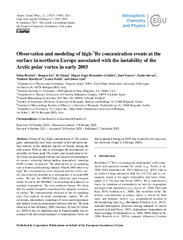Приказ основних података о документу
Observation and modeling of high-7Be concentration events at the surface in northern Europe associated with the instability of the Arctic polar vortex in early 2003
| dc.creator | Brattich, Erika | |
| dc.creator | Liu, Hongyu | |
| dc.creator | Zhang, Bo | |
| dc.creator | Hernández-Ceballos, Miguel Ángel | |
| dc.creator | Paatero, Jussi | |
| dc.creator | Sarvan, Darko | |
| dc.creator | Djurdjević, Vladimir | |
| dc.creator | Tositti, Laura | |
| dc.creator | Ajtić, Jelena | |
| dc.date.accessioned | 2021-12-29T08:10:20Z | |
| dc.date.available | 2021-12-29T08:10:20Z | |
| dc.date.issued | 2021 | |
| dc.identifier.issn | 1680-7316 | |
| dc.identifier.uri | https://vet-erinar.vet.bg.ac.rs/handle/123456789/2336 | |
| dc.description.abstract | Abstract. Events of very high concentrations of 7Be cosmogenic radionuclide have been recorded at low-elevation surface stations in the subpolar regions of Europe during the cold season. With an aim to investigate the mechanisms responsible for those peak 7Be events, and in particular to verify if they are associated with the fast descent of stratospheric air masses occurring during sudden stratospheric warming (SSW) events, we analyze 7Be observations at six sampling sites in Fennoscandia during January–March 2003 when very high 7Be concentrations were observed and the Arctic vortex was relatively unstable as a consequence of several SSW events. We use the GEOS-Chem chemistry and transport model driven by the MERRA-2 meteorological reanalysis to simulate tropospheric 7Be over northern Europe. We show that the model reasonably reproduces the temporal evolution of surface 7Be concentrations observed at the six sampling sites. Our analysis of model simulations, surface 7Be observations, atmospheric soundings of ozone and temperature and surface ozone measurements indicates that the 7Be peak observed in late February 2003 (between 20 and 28 February 2003) at the six sampling sites in Fennoscandia was associated with downward transport of stratospheric vortex air that originated during an SSW that occurred a few days earlier (between 18 and 21 February 2003). | |
| dc.language | English | |
| dc.relation | info:eu-repo/grantAgreement/MESTD/inst-2020/200143/RS// | |
| dc.relation | info:eu-repo/grantAgreement/MESTD/inst-2020/200162/RS// | |
| dc.relation | NASA Modeling, Analysis and Prediction (MAP) program (grant no. 80NSSC17K0221) | |
| dc.relation | Atmospheric Composition Campaign Data Analysis and Modeling (ACCDAM) program (grant no. NNX14AR07G) | |
| dc.relation.isreferencedby | https://vet-erinar.vet.bg.ac.rs/handle/123456789/2048 | |
| dc.relation.isreferencedby | https://doi.org/10.5194/acp-21-17927-2021-supplement | |
| dc.relation.isreferencedby | https://doi.org/10.5281/zenodo.4117521 | |
| dc.rights | openAccess | |
| dc.rights.uri | https://creativecommons.org/licenses/by/4.0/ | |
| dc.source | Atmospheric Chemistry and Physics | |
| dc.title | Observation and modeling of high-7Be concentration events at the surface in northern Europe associated with the instability of the Arctic polar vortex in early 2003 | |
| dc.type | article | en |
| dc.rights.license | BY | |
| dc.citation.volume | 21 | |
| dc.citation.issue | 23 | |
| dc.citation.spage | 17927 | |
| dc.citation.epage | 17951 | |
| dc.citation.rank | aM21 | |
| dc.description.other | Supplementary material: [https://vet-erinar.vet.bg.ac.rs/handle/123456789/2048] | |
| dc.identifier.wos | 000728464300001 | |
| dc.identifier.doi | 10.5194/acp-21-17927-2021 | |
| dc.identifier.scopus | 2-s2.0-85121207219 | |
| dc.identifier.fulltext | http://veterinar.vet.bg.ac.rs/bitstream/id/6471/acp-21-17927-2021.pdf | |
| dc.type.version | publishedVersion |

